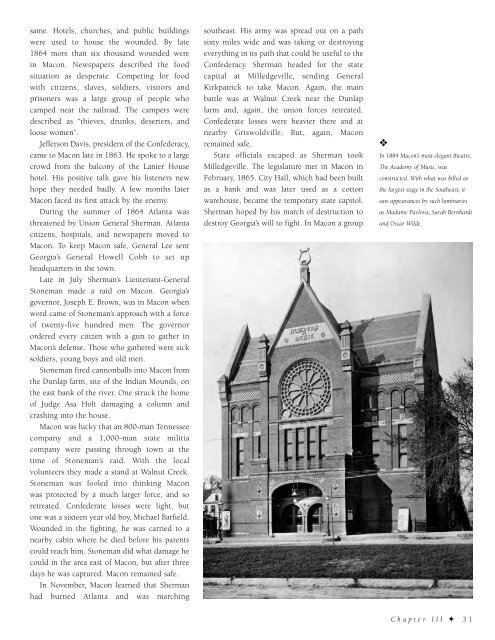Historic Macon
An illustrated history of the city of Macon, paired with the histories of companies, families and organizations that make the region great.
An illustrated history of the city of Macon, paired with the histories of companies, families and organizations that make the region great.
Create successful ePaper yourself
Turn your PDF publications into a flip-book with our unique Google optimized e-Paper software.
same. Hotels, churches, and public buildings<br />
were used to house the wounded. By late<br />
1864 more than six thousand wounded were<br />
in <strong>Macon</strong>. Newspapers described the food<br />
situation as desperate. Competing for food<br />
with citizens, slaves, soldiers, visitors and<br />
prisoners was a large group of people who<br />
camped near the railroad. The campers were<br />
described as “thieves, drunks, deserters, and<br />
loose women”.<br />
Jefferson Davis, president of the Confederacy,<br />
came to <strong>Macon</strong> late in 1863. He spoke to a large<br />
crowd from the balcony of the Lanier House<br />
hotel. His positive talk gave his listeners new<br />
hope they needed badly. A few months later<br />
<strong>Macon</strong> faced its first attack by the enemy.<br />
During the summer of 1864 Atlanta was<br />
threatened by Union General Sherman. Atlanta<br />
citizens, hospitals, and newspapers moved to<br />
<strong>Macon</strong>. To keep <strong>Macon</strong> safe, General Lee sent<br />
Georgia’s General Howell Cobb to set up<br />
headquarters in the town.<br />
Late in July Sherman’s Lieutenant-General<br />
Stoneman made a raid on <strong>Macon</strong>. Georgia’s<br />
governor, Joseph E. Brown, was in <strong>Macon</strong> when<br />
word came of Stoneman’s approach with a force<br />
of twenty-five hundred men. The governor<br />
ordered every citizen with a gun to gather in<br />
<strong>Macon</strong>’s defense. Those who gathered were sick<br />
soldiers, young boys and old men.<br />
Stoneman fired cannonballs into <strong>Macon</strong> from<br />
the Dunlap farm, site of the Indian Mounds, on<br />
the east bank of the river. One struck the home<br />
of Judge Asa Holt damaging a column and<br />
crashing into the house.<br />
<strong>Macon</strong> was lucky that an 800-man Tennessee<br />
company and a 1,000-man state militia<br />
company were passing through town at the<br />
time of Stoneman’s raid. With the local<br />
volunteers they made a stand at Walnut Creek.<br />
Stoneman was fooled into thinking <strong>Macon</strong><br />
was protected by a much larger force, and so<br />
retreated. Confederate losses were light, but<br />
one was a sixteen year old boy, Michael Barfield.<br />
Wounded in the fighting, he was carried to a<br />
nearby cabin where he died before his parents<br />
could reach him. Stoneman did what damage he<br />
could in the area east of <strong>Macon</strong>, but after three<br />
days he was captured. <strong>Macon</strong> remained safe.<br />
In November, <strong>Macon</strong> learned that Sherman<br />
had burned Atlanta and was marching<br />
southeast. His army was spread out on a path<br />
sixty miles wide and was taking or destroying<br />
everything in its path that could be useful to the<br />
Confederacy. Sherman headed for the state<br />
capital at Milledgeville, sending General<br />
Kirkpatrick to take <strong>Macon</strong>. Again, the main<br />
battle was at Walnut Creek near the Dunlap<br />
farm and, again, the union forces retreated.<br />
Confederate losses were heavier there and at<br />
nearby Griswoldville. But, again, <strong>Macon</strong><br />
remained safe.<br />
State officials escaped as Sherman took<br />
Milledgeville. The legislature met in <strong>Macon</strong> in<br />
February, 1865. City Hall, which had been built<br />
as a bank and was later used as a cotton<br />
warehouse, became the temporary state capitol.<br />
Sherman hoped by his march of destruction to<br />
destroy Georgia’s will to fight. In <strong>Macon</strong> a group<br />
❖<br />
In 1884 <strong>Macon</strong>’s most elegant theatre,<br />
The Academy of Music, was<br />
constructed. With what was billed as<br />
the largest stage in the Southeast, it<br />
saw appearances by such luminaries<br />
as Madame Pavlova, Sarah Bernhardt<br />
and Oscar Wilde.<br />
Chapter III ✦ 31
















